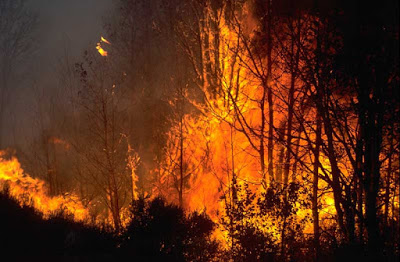
New fossil evidence shows that Australia’s fire-prone shrubland open vegetation originated at least 70 million years ago — 40-50 million years earlier than previously thought.
The findings, published online ahead of print in the American Journal of Botany, reject prevailing wisdom that Australia was covered with rainforest until 40 million years ago, and that currently dominant native vegetation types evolved after that on a drying continent with increasing fire.
“I grew up and started working believing that this iconic Australian vegetation evolved under the influence of fires as the rainforests dried out, largely over the last 25 million years or so. But it now looks like our fire-prone vegetation has much more ancient origins,” says co-author Professor Bob Hill, Executive Dean of the University of Adelaide’s Faculty of Sciences.
“This dryland, fire-prone vegetation actually precedes the mega-rainforests and it somehow managed to survive through the wetter times.”
The breakthrough comes out of a long-term research partnership of about 30 years between Professor Hill and colleagues Dr Ray Carpenter (Research Fellow at University of Tasmania and University of Adelaide), Associate Professor Greg Jordan (University of Tasmania) and Dr Mike Macphail (Australian National University).
The researchers studied sediment, dated from the Late Cretaceous period by Dr Macphail, from core drilled in the Bundey Basin of central Australia, northeast of Alice Springs, by the Northern Territory Geological Survey. Dr Carpenter detected numerous tiny leaf fragments from the family Proteaceae, which now includes well-known native plants such as Banksia, Macadamia and Grevillea. It was also evident that fire had been part of the landscape from the preserved charcoal material.
“Amazingly, we think part of the ancient vegetation was similar to what you can now see in south-western Australia, and there were even a couple of leaf bits that look just like Banksia,” says Dr Carpenter.
“Banksia is one of Australia’s most iconic native plants and is very often associated with fire. Somehow this family of plants has shown extraordinary persistence over an incredibly long period of time, through extremely variable climatic conditions.”
Associate Professor Jordan says the widespread burning of the Late Cretaceous is likely to have reduced the amount of phosphorus in the soils.
“Wildfires would have promoted the spread of plants like Proteaceae, able to thrive on these marginal soils and giving them a competitive advantage,” Associate Professor Jordan says.
“We’re a long way from properly understanding how to manage fire in our landscape now,” says Professor Hill. “To do that we need to understand how fire and vegetation co-evolved. This research is a significant step towards that understanding.”
Reference:
R. J. Carpenter, M. K. Macphail, G. J. Jordan, R. S. Hill. Fossil evidence for open, Proteaceae-dominated heathlands and fire in the Late Cretaceous of Australia. American Journal of Botany, 2015; DOI: 10.3732/ajb.1500343
Note: The above post is reprinted from materials provided by University of Adelaide.










